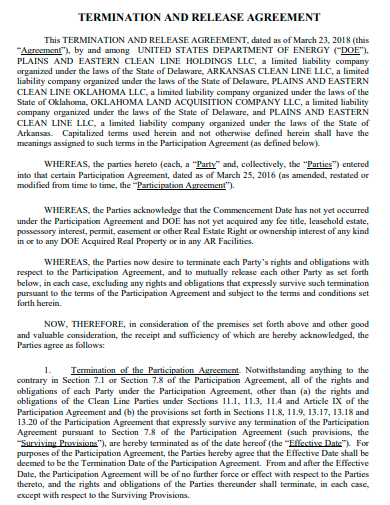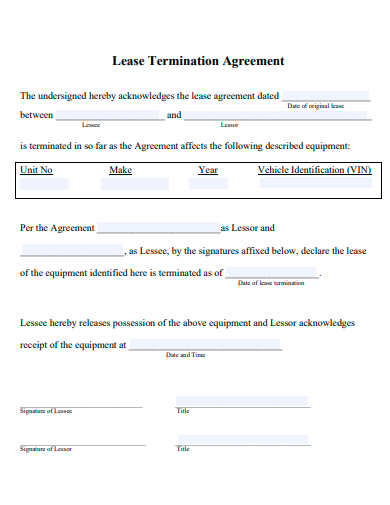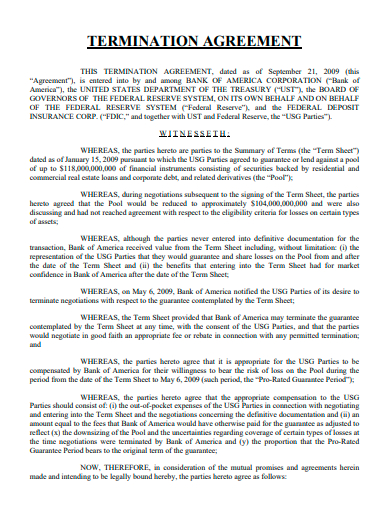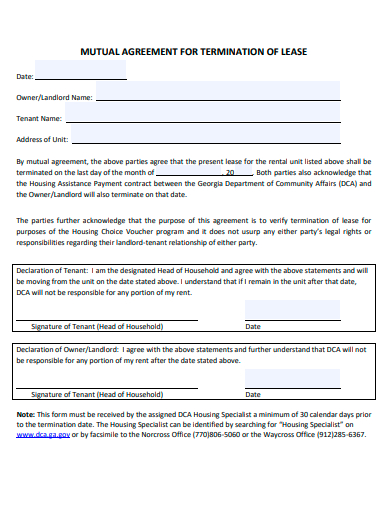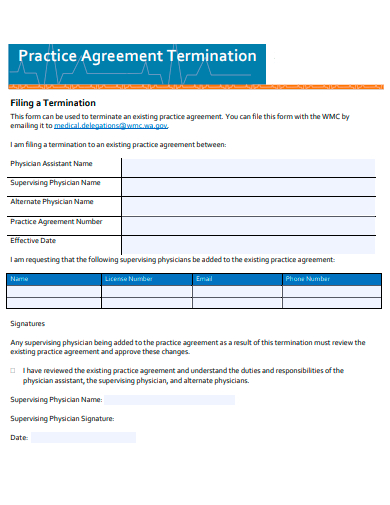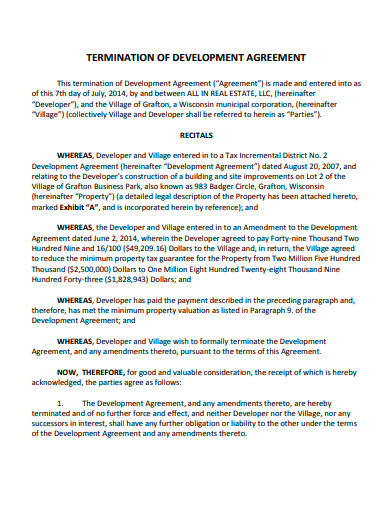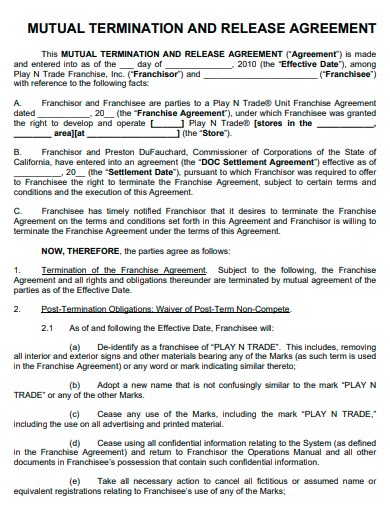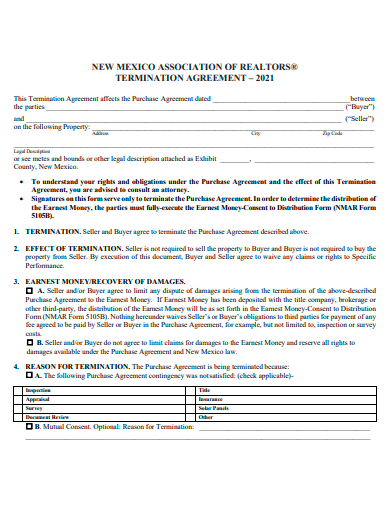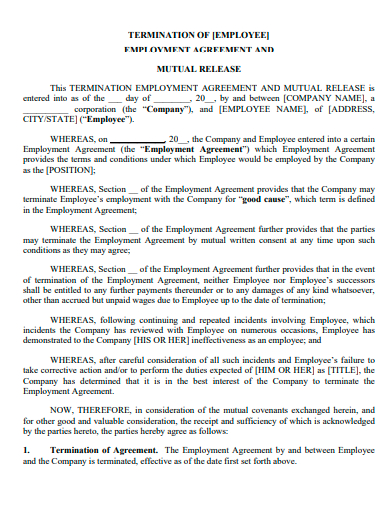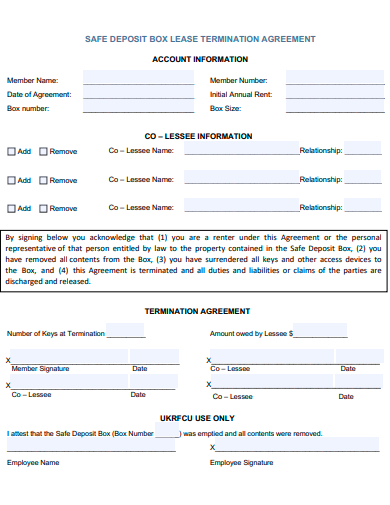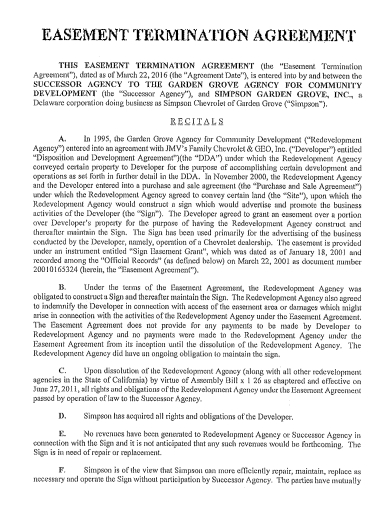An agreement is a legally enforceable agreement that binds the signees together; yet, there are situations when it may be necessary to pull out of a contract that has already been made. In circumstances like these, it is critical to properly handle the immediate termination of the contract in order to eliminate the possibility of legal services and action being taken. In any sector, it is critical for a firm to have a system in place to handle the termination agreement procedure, whether it be for a new employee or a business partnership. Many people find that writing and sending a letter of termination helps them handle this process in a more professional manner. If you work in HR or a function that is somewhat analogous to HR department, you can assess which ways can best address your situation by learning about this agreement and reading it.
FREE 10+ Termination Agreement Samples
1. Termination and Release Agreement
2. Lease Termination Agreement
3. Termination Agreement Example
4. Termination of Lease Mutual Agreement
5. Termination Practice Agreement
6. Termination of Development Agreement
7. Mutual Termination and Release Agreement
8. Basic Termination Agreement
9. Termination Employment Agreement
10. Safe Deposit Box Lease Termination Agreement
11. Easement Termination Agreement
What Is a Termination Agreement?
A termination agreement is a formal document declaration that all parties to a contract formally consent to the contract being terminated with all its policy and procedure. There are a few other names for a termination agreement, including the Termination of contract and Notice of cancellation of the contract. In addition, it is the practice of terminating a contract before all parties’ performance has reached its full potential. The parties’ capacity to fulfill the commitments outlined in the agreement is limited before they have the opportunity to meet all of the obligations outlined in the agreement. The agreement is terminated, and as a result, the parties are released from any remaining responsibilities under the terms of service agreement.
How To Make Termination Agreement?
Sometimes, the duties and obligations outlined in a contract simply cannot be fulfilled. You may be unhappy with the way the other party is carrying out their responsibilities, or it’s also possible that you no longer require their services, and look for early termination. When this occurs, there will be a mutual termination where you can send a agreement to the other party to make it crystal obvious that the contract has been terminated. Therefore, you can read the procedures provided below to assist you in formulating an efficient deal.
1. Examine The Contract
Numerous contracts have clauses that outline the terms under which either party may end the agreement. If your agreement has them, getting out of the contract may be a reasonably simple process; you have to check to see if the termination terms apply to you and let the other parties know.
2. Claim Impossibility of Performance
You have the right to file a claim of contractual impossibility if you reasonably believe that you cannot fulfill your duties under the contract. You will need to demonstrate that the impossible conditions are due to the activities of the other party or an act of nature if you use this strategy roadmap, which is not typically suggested.
3. Declare Your Purpose
You have the right to walk away from a contract if the purpose it was created to fulfill no longer exists, often known as being “frustrated.” For instance, if you rented out your property while you worked abroad but were compelled to return to the United States due to political unrest, you can terminate the lease.
4. Negotiate With Your Associates
Through open and frank communication, it’s possible that your issues can be resolved. If you provide your partners with an explanation as to why you want out of the deal, they may be willing to comply with your request. You may even sweeten the sale by offering an incentive, such as a refund of the cancellation policy charge, to the customer.
What aspects of a termination agreement are the most significant?
When the contract is terminated, the termination agreement governs who gets what rewards, rights, and duties and how those things are distributed between the parties involved in the agreement.
What does it mean when a contract has a termination clause?
Employment contracts typically include termination clauses, also referred to as severance clauses.
What are the repercussions of calling it quits?
The “impact of termination” provision is one of the terms that most frequently appear in acquisition agreements. The provision, as its name suggests, indicates the parties’ agreement regarding what liability each party will have to the other when the contract is terminated. It expresses the parties’ agreement regarding what the penalty will be.
In these agreements, it is clear that all parties concerned have independently decided to terminate the relationship. They might include a voluntary mutual release of claims, but that’s not required.
Related Posts
FREE 10+ Trial Agreement Samples In MS Word | Google Docs | Apple Pages | PDF
FREE 9+ Shop Rental Agreement Samples [ Commercial, Lease, Tenancy ]
FREE 10+ Charter Agreement Samples In MS Word | Google Docs | Apple Pages | PDF
FREE 10+ Mentoring Agreement Samples In MS Word | Apple Pages | PDF
FREE 10+ Partner Agreement Samples In MS Word | Google Docs | Apple Pages | PDF
FREE 10+ Individual Agreement Samples In MS Word | Google Docs | Apple Pages | PDF
FREE 10+ Strategic Agreement Samples In MS Word | Google Docs | Apple Pages | PDF
FREE 10+ Equity Agreement Samples In MS Word | Google Docs | Apple Pages | PDF
FREE 10+ Producer Agreement Samples in MS Word | Apple Pages | PDF
FREE 10+ Grant Agreement Samples In MS Word | Apple Pages | PDF
FREE 8+ Meeting Agreement Samples in MS Word | Google Docs | Apple Pages | PDF
FREE 10+ Community Agreement Samples In MS Word | Google Docs | PDF
FREE 8+ Real Estate Option Agreement Samples in MS Word | PDF
FREE 10+ Call Option Agreement Samples In MS Word | PDF
FREE 10+ Advertising Agreement Samples In MS Word | Google Docs | Apple Pages | PDF

